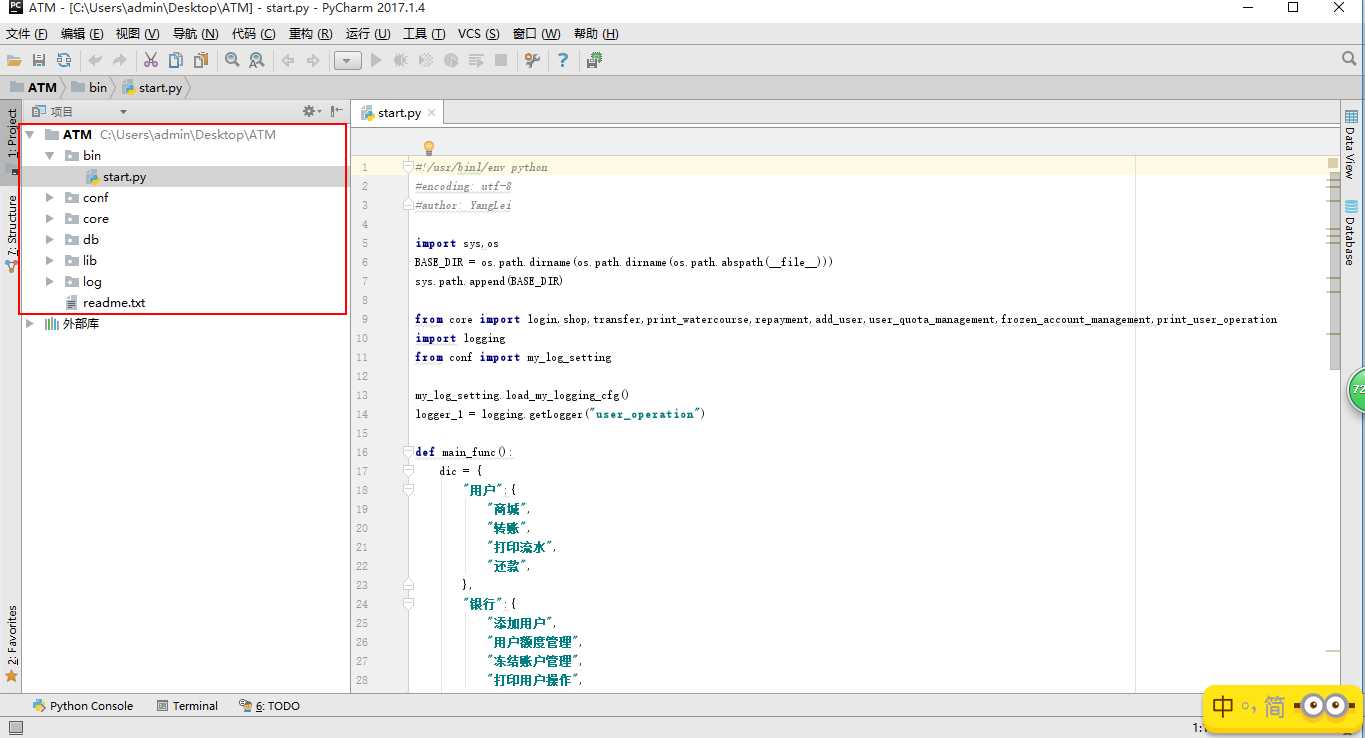标签:opener 写入 配置文件 break usr gre creat filter ogg
1.定义
协程函数就是使用了yield表达式形式的生成器。
#!/usr/binl/env python
#encoding: utf-8
#author: YangLei
def eater(name):
print("%s eat food" %name)
while True:
food = yield
g = eater("yanglei")
print(g)
2.执行过程
运行协程函数,要先next(),对协程函数进行初始化函数,然后再send() ,send会给yield传一个值。
next()与send()的区别:
next():让函数初始化。
send():触发下一次代码的执行时,会给yield赋值。
#!/usr/binl/env python
#encoding: utf-8
#author: YangLei
def eater(name):
print(‘%s 说:我开动啦‘ %name)
food_list=[]
while True:
food=yield food_list
food_list.append(food)
print(‘%s eat %s‘ %(name,food))
def producer():
alex_g=eater(‘xiaolan‘)
next(alex_g)
while True:
food=input(‘>>: ‘).strip()
if not food:continue
print(alex_g.send(food))
producer()
3.装饰器扩展
协程函数与装饰器的结合,可以避免忘记初始化函数
#!/usr/binl/env python
#encoding: utf-8
#author: YangLei
def init(func):
def wrapper(*args,**kwargs):
res = func(*args,**kwargs)
next(res)
return res
return wrapper
@init
def eater(name):
print("%s eat food" %name)
food_list=[]
while True:
food = yield food_list
print("%s star to eat %s" %(name,food))
food_list.append(food)
g = eater("xiaolan")
print(g.send("火锅"))
print(g.send("烤肉"))
print(g.send("烤鱼"))
4.面向过程应用
面向过程:核心是过程二字,过程即解决问题的步骤,基于面向过程去设计程序就像是在设计一条工业流水线,是一种机械式的思维方式。
优点:程序结构清晰,可以把复杂的问题简单化,流程化。
缺点:可扩展性差,一条流线只是用来解决一个问题。
#!/usr/binl/env python
#encoding: utf-8
#author: YangLei
#grep -rl ‘error‘ /dir/
import os
def init(func):
def wrapper(*args,**kwargs):
g=func(*args,**kwargs)
next(g)
return g
return wrapper
#第一阶段:找到所有文件的绝对路径
@init
def search(target):
while True:
filepath=yield
g=os.walk(filepath)
for pardir,_,files in g:
for file in files:
abspath=r‘%s\%s‘ %(pardir,file)
target.send(abspath)
#第二阶段:打开文件
@init
def opener(target):
while True:
abspath=yield
with open(abspath,‘rb‘) as f:
target.send((abspath,f))
#第三阶段:循环读出每一行内容
@init
def cat(target):
while True:
abspath,f=yield #(abspath,f)
for line in f:
res=target.send((abspath,line))
if res:break
#第四阶段:过滤
@init
def grep(pattern,target):
tag=False
while True:
abspath,line=yield tag
tag=False
if pattern in line:
target.send(abspath)
tag=True
#第五阶段:打印该行属于的文件名
@init
def printer():
while True:
abspath=yield
print(abspath)
g = search(opener(cat(grep(‘error‘.encode(‘utf-8‘), printer()))))
g.send(r‘F:\python\s18‘)
1.递归调用
在调用一个函数的过程中,直接或间接地调用了函数本身,我们称为递归的调用。
(1)直接调用
#!/usr/binl/env python
#encoding: utf-8
#author: YangLei
def func():
print(‘the is func‘)
func()
func()
(2)间接调用
#!/usr/binl/env python
#encoding: utf-8
#author: YangLei
def foo():
print(‘the is foo‘)
bar()
def bar():
print(‘the is bar‘)
foo()
foo()
2.递归的执行
递归的执行分为两个阶段递推和回溯。
#!/usr/binl/env python
#encoding: utf-8
#author: YangLei
def age(n):
if n == 1:
return 18
return age(n-1)+2
print(age(5))

算法:当数据量很大适宜采用该方法。采用二分法查找时,数据需是排好序的。主要思想是:(设查找的数组区间为array[low, high])。
#!/usr/binl/env python
#encoding: utf-8
#author: YangLei
l = [1,2,5,7,10,31,44,47,56,99,102,130,240]
def binary_search(l,num):
print(l)
if len(l) > 1:
mid_index=len(l)//2
if num > l[mid_index]:
#in the right
l=l[mid_index:]
binary_search(l,num)
elif num < l[mid_index]:
#in the left
l=l[:mid_index]
binary_search(l,num)
else:
print(‘find it‘)
else:
if l[0] == num:
print(‘find it‘)
else:
print(‘not exist‘)
return
binary_search(l,31)
1.执行源文件。
2.以一个源文件的全局名称空间。
3.在当前位置拿到一个模块名,指向2创建的名称空间。
#!/usr/binl/env python
#encoding: utf-8
#author: YangLei
print(‘from the spam.py‘)
money=0
x=1
def read1():
print(‘spam->read1->money‘,money)
def read2():
print(‘spam->read2 calling read‘)
read1()
def change():
global money
money=0
#!/usr/binl/env python
#encoding: utf-8
#author: YangLei
import spam
money=100000000000
def read1():
print(‘from test‘)
print(spam.money)
print(spam.read1)
spam.read1()
spam.read2()
spam.change()
print(money)
spam.read1()
import spam as s1
print(s1.money)
优点:使用源文件内的名字时无需加前缀,使用方便。
缺点:容易与当前文件的名称空间内的名字混淆。
#!/usr/binl/env python
#encoding: utf-8
#author: YangLei
print(‘from the spam.py‘)
money=0
x=1
def read1():
print(‘spam->read1->money‘,money)
def read2():
print(‘spam->read2 calling read‘)
read1()
def change():
global money
money=0
#!/usr/binl/env python #encoding: utf-8 #author: YangLei from spam import money,read1,read2,change money=0 print(money) print(read1) read1() def read1():print(‘ok‘) read2() money=10 change() print(money) from spam import money as m print(m)
注意:自定义的模块名一定不要与python自带的模块名重名
内存中---> 内置模块---> sys.path
#!/usr/binl/env python
#encoding: utf-8
#author: YangLei
print(‘from the spam.py‘)
money=0
x=1
def read1():
print(‘spam->read1->money‘,money)
def read2():
print(‘spam->read2 calling read‘)
read1()
def change():
global money
money=0
#!/usr/binl/env python #encoding: utf-8 #author: YangLei import time import importlib import spam time.sleep(20) import spam print(spam.money) importlib.reload(spam) print(spam.money) import sys print(‘time‘ in sys.modules) import time print(‘time‘ in sys.modules)
当spam在别的路径时
#!/usr/binl/env python #encoding: utf-8 #author: YangLei import sys # print(sys.path) sys.path.insert(0,r‘F:\python\s18\day5\test‘) import spam
(1)无论是import形式还是from...import形式,凡是在导入语句中(而不是在使用时)遇到带点的,都要第一时间提高警觉:这是关于包才有的导入语法
(2)包是目录级的(文件夹级),文件夹是用来组成py文件(包的本质就是一个包含__init__.py文件的目录)
(3)import导入文件时,产生名称空间中的名字来源于文件,import 包,产生的名称空间的名字同样来源于文件,即包下的__init__.py,导入包本质就是在导入该文件
1.绝对导入
#!/usr/binl/env python #encoding: utf-8 #author: YangLei import sys print(sys.path) sys.path.append(r‘F:\python\s18\day5‘) import aaa print(aaa) print(aaa.x) print(aaa.y) aaa.m1.func1() aaa.bbb.m3.func3() aaa.func1() aaa.func2() aaa.func3() import aaa.bbb.m3 as abm abm.func3()
2.相对导入
#!/usr/binl/env python #encoding: utf-8 #author: YangLei import sys sys.path.append(r‘C:\Users\Administrator\PycharmProjects\python18期周末班\day5\a‘) import glance_v1 glance_v1.get() glance_v1.create_resource(‘test.conf‘) glance_v1.main() glance_v1.register_models(‘mysql‘)

以项目来命名,项目文件夹中要包含bin文件夹、conf文件夹、core文件夹、db文件夹、lib文件夹、log文件夹和readme。
1.使用方法
(1)如果不指定filename,则默认打印到终端
(2)指定日志级别:
指定方式:
1:level=10
2:level=logging.ERROR
日志级别种类:
CRITICAL = 50
FATAL = CRITICAL
ERROR = 40
WARNING = 30
WARN = WARNING
INFO = 20
DEBUG = 10
NOTSET = 0
(3)指定日志级别为ERROR,则只有ERROR及其以上级别的日志会被打印
logging.basicConfig(filename=‘access.log‘,
format=‘%(asctime)s - %(name)s - %(levelname)s -%(module)s: %(message)s‘,
datefmt=‘%Y-%m-%d %H:%M:%S %p‘,
level=10)
logging.debug(‘debug‘)
logging.info(‘info‘)
logging.warning(‘warning‘)
logging.error(‘error‘)
logging.critical(‘critical‘)
logging.log(10,‘log‘)
2.自定义logging
"""
logging配置
"""
import os
import logging.config
# 定义三种日志输出格式 开始
standard_format = ‘[%(asctime)s][%(threadName)s:%(thread)d][task_id:%(name)s][%(filename)s:%(lineno)d]‘ ‘[%(levelname)s][%(message)s]‘ #其中name为getlogger指定的名字
simple_format = ‘[%(levelname)s][%(asctime)s][%(filename)s:%(lineno)d]%(message)s‘
id_simple_format = ‘[%(levelname)s][%(asctime)s] %(message)s‘
# 定义日志输出格式 结束
logfile_dir = os.path.dirname(os.path.abspath(__file__)) # log文件的目录
logfile_name = ‘all2.log‘ # log文件名
# 如果不存在定义的日志目录就创建一个
if not os.path.isdir(logfile_dir):
os.mkdir(logfile_dir)
# log文件的全路径
logfile_path = os.path.join(logfile_dir, logfile_name)
# log配置字典
LOGGING_DIC = {
‘version‘: 1,
‘disable_existing_loggers‘: False,
‘formatters‘: {
‘standard‘: {
‘format‘: standard_format
},
‘simple‘: {
‘format‘: simple_format
},
},
‘filters‘: {},
‘handlers‘: {
#打印到终端的日志
‘console‘: {
‘level‘: ‘DEBUG‘,
‘class‘: ‘logging.StreamHandler‘, # 打印到屏幕
‘formatter‘: ‘simple‘
},
#打印到文件的日志,收集info及以上的日志
‘default‘: {
‘level‘: ‘DEBUG‘,
‘class‘: ‘logging.handlers.RotatingFileHandler‘, # 保存到文件
‘formatter‘: ‘standard‘,
‘filename‘: logfile_path, # 日志文件
‘maxBytes‘: 1024*1024*5, # 日志大小 5M
‘backupCount‘: 5,
‘encoding‘: ‘utf-8‘, # 日志文件的编码,再也不用担心中文log乱码了
},
},
‘loggers‘: {
#logging.getLogger(__name__)拿到的logger配置
‘‘: {
‘handlers‘: [‘default‘, ‘console‘], # 这里把上面定义的两个handler都加上,即log数据既写入文件又打印到屏幕
‘level‘: ‘DEBUG‘,
‘propagate‘: True, # 向上(更高level的logger)传递
},
},
}
def load_my_logging_cfg():
logging.config.dictConfig(LOGGING_DIC) # 导入上面定义的logging配置
logger = logging.getLogger(__name__) # 生成一个log实例
logger.info(‘It works!‘) # 记录该文件的运行状态
if __name__ == ‘__main__‘:
load_my_logging_cfg()
logging配置文件
标签:opener 写入 配置文件 break usr gre creat filter ogg
原文地址:http://www.cnblogs.com/00doudou00/p/7272323.html